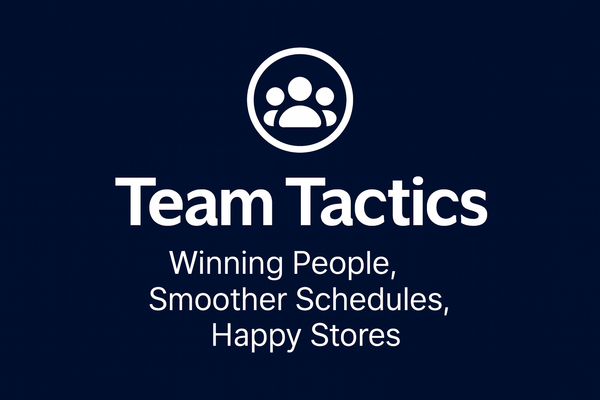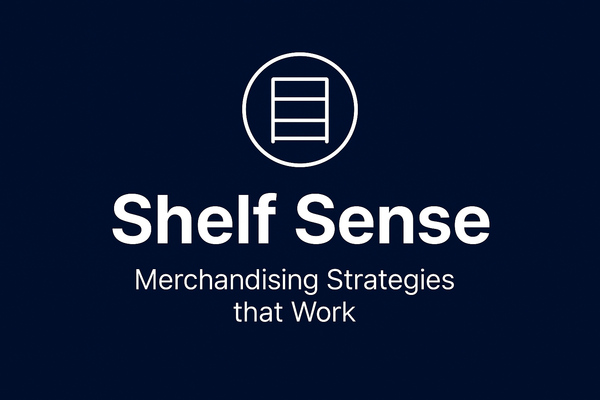Turning Shelf Zombies Into Cash: The Manager's Guide to Dead Inventory Revival
Kevin Walsh stared at the three cases of pomegranate energy drinks that had been sitting in his Survival Stop's back room for six months. At $4.99 each, those 72 cans represented nearly $360 in tied-up cash—money that could've been invested in products customers actually wanted.

Kevin Walsh stared at the three cases of pomegranate energy drinks that had been sitting in his Survival Stop's back room for six months. At $4.99 each, those 72 cans represented nearly $360 in tied-up cash—money that could've been invested in products customers actually wanted. But there they sat, gathering dust like expensive paperweights.
"I kept thinking someone would eventually buy them," Kevin admits. "Meanwhile, I was running low on popular items but couldn't afford to reorder because my cash was locked up in stuff nobody wanted. That's when I realized dead inventory wasn't just taking up space—it was slowly strangling my store's profitability."
Kevin's pomegranate problem isn't unique. Industry research shows the average convenience store carries 12-18% dead inventory at any given time, representing thousands of dollars in stagnant capital. But smart managers have learned that dead inventory isn't actually dead—it just needs the right resuscitation techniques.
The Hidden Cost of Shelf Zombies
Dead inventory is sneaky. It doesn't announce itself with alarms or flashing lights. Instead, it quietly occupies valuable real estate while generating zero revenue, creating a cascade of hidden costs that many managers don't fully appreciate.
Opportunity cost hits hardest. Every square inch occupied by slow-moving products represents space that could showcase fast-turning, profitable items. When prime eye-level shelf space holds stagnant inventory, stores miss countless sales opportunities.
Cash flow strangulation occurs gradually. Dead inventory ties up working capital that could fund popular products, emergency orders, or store improvements. The longer products sit, the more they drain financial flexibility.
Storage inefficiency compounds the problem. Back rooms stuffed with dead inventory can't accommodate fast-moving products, forcing managers to reject profitable opportunities or pay premium prices for emergency deliveries.
"I calculated that dead inventory was costing me about $2,400 monthly in lost opportunities," explains Maria Rodriguez, whose inventory turnaround strategies increased store profitability by 31%. "That's money just sitting there doing nothing while I struggled to keep popular items in stock."
Identifying Your Store's Walking Dead
The first step in dead inventory revival is accurate identification. Many managers rely on gut feelings, but successful inventory turnarounds require systematic analysis.
Sales velocity analysis reveals which products haven't moved in 30, 60, or 90 days. Modern POS systems can generate these reports automatically, highlighting slow movers before they become true zombies.
Seasonal consideration prevents premature burial. Winter items might appear dead in July but could revive come December. Smart managers distinguish between truly dead products and seasonally dormant ones.
Margin evaluation helps prioritize revival efforts. High-margin dead inventory deserves more aggressive rescue attempts than low-profit items that might be better candidates for quick disposal.
Jennifer Park learned this lesson after mistakenly clearancing seasonal hot chocolate in August: "I thought it was dead inventory, so I marked it down 75% just to get rid of it. Come winter, I had to reorder the same product at full wholesale price. Sometimes patience pays better than panic."
The Markdown Strategy: Pricing for Movement
Strategic markdowns represent the most straightforward dead inventory revival technique, but success requires more finesse than slapping "50% OFF" stickers everywhere.
Graduated markdowns start conservatively and increase over time. Begin with 20-30% reductions to test price sensitivity, then escalate if movement remains slow. This approach maximizes recovery while avoiding unnecessary profit sacrifice.
Psychological pricing leverages customer behavior patterns. Pricing at $1.99 instead of $2.00 or creating "3 for $5" deals often generates more movement than straight percentage discounts.
Strategic timing maximizes markdown effectiveness. Friday afternoon markdowns catch weekend shoppers, while Monday morning reductions target weekly bargain hunters. Understanding customer traffic patterns optimizes markdown timing.
"I used to just mark everything down 50% and hope for the best," recalls David Kim, whose refined markdown strategy improved dead inventory turnover by 67%. "Now I test different price points and watch what actually moves. Sometimes a 25% reduction sells just as well as 50%, keeping more profit in my pocket."
Bundle Magic: Creating Value from Leftovers
Creative bundling transforms dead inventory into attractive offers that customers perceive as valuable deals rather than desperate clearance attempts.
Complementary product bundling pairs slow movers with popular items. Stagnant energy bars might move when bundled with fast-selling energy drinks. Dead candy could revive when paired with popular sodas.
Theme-based packages create logical groupings that make sense to customers. "Movie night" bundles combining slow-moving popcorn with popular candy and drinks can move multiple dead items simultaneously.
Cross-category combinations surprise customers with unexpected value. Bundling automotive items with snacks for road trips or combining phone accessories with beverages creates novel purchase incentives.
Lisa Courtney's bundling success story illustrates the approach: "I had cases of expensive granola bars gathering dust. Bundled them with popular coffee as 'breakfast combos' and moved 90% within three weeks. Customers loved the convenience, and I recovered most of my investment."
Promotional Firepower: Events That Generate Buzz
Well-executed promotions can breathe life into seemingly hopeless inventory while generating store traffic and customer excitement.
Flash sales create urgency around dead inventory. Limited-time offers encourage immediate purchase decisions rather than "I'll think about it" deferrals that typically doom slow-moving products.
Customer challenges gamify dead inventory movement. "Try something new" contests or social media photo challenges can generate interest in overlooked products while building customer engagement.
Staff incentive programs motivate employees to actively promote slow movers. Small bonuses for selling dead inventory often generate impressive results while educating staff about effective sales techniques.
"Our 'mystery product Monday' promotion turned dead inventory clearance into a weekly event customers anticipated," explains Peter Martinez. "We'd feature a different slow mover each week with special pricing and staff recommendations. It became a game for regular customers to try new things."
Supplier Relationship Surgery: Preventing Future Zombies
Sometimes, dead inventory problems require addressing root causes through supplier relationship adjustments rather than just treating symptoms.
Return negotiations with vendors can recover some value from truly unsaleable products. Many suppliers accept returns on defective or extremely slow-moving items, especially if managers maintain good relationships and reasonable return frequencies.
Consignment arrangements shift inventory risk to suppliers for experimental or seasonal products. Under consignment deals, stores only pay for items actually sold, eliminating dead inventory risk entirely.
Order quantity renegotiation prevents future dead inventory by adjusting minimum orders, delivery frequencies, or product mixes based on actual sales data rather than supplier preferences.
"My candy vendor was pushing large orders with slow-moving flavors mixed in," recalls Amanda Foster. "I negotiated smaller, more frequent deliveries focused on proven sellers. My candy dead inventory dropped from 23% to under 5%, and ironically, my candy sales increased because I had fresher, more popular varieties."
Technology-Assisted Resurrection
Modern technology provides powerful tools for dead inventory identification and revival that many convenience store managers underutilize.
Automated reporting flags slow movers before they become problems. Setting up weekly reports for products with zero sales in 14 days allows early intervention before inventory truly dies.
Dynamic pricing systems can automatically adjust prices based on inventory age, sales velocity, and preset rules. These systems execute graduated markdown strategies without constant manual oversight.
Customer communication platforms enable targeted promotions to specific customer segments. Email lists or loyalty program messaging can promote dead inventory to customers most likely to purchase.
The Quick-Flip Strategy: Emergency Evacuation
Sometimes, dead inventory requires immediate evacuation regardless of profit recovery. Quick-flip strategies prioritize cash flow and space recovery over margin preservation.
Bulk employee sales move large quantities quickly while providing staff benefits. Offering dead inventory to employees at cost creates goodwill while clearing space.
Donation tax benefits provide value recovery through tax deductions while supporting community organizations. Local charities often welcome product donations that provide more value than dumpster disposal.
Liquidation partnerships with discount retailers or online resellers can recover some value from hopeless inventory while maintaining store reputation.
Prevention: The Best Cure
The most effective dead inventory strategy is prevention through smarter buying decisions and monitoring systems.
Test quantities for new products limit exposure while gauging customer interest. Starting with minimal orders prevents large dead inventory accumulation when products fail to catch on.
Regular velocity monitoring catches slow movers early when revival strategies are most effective. Weekly reviews prevent minor slowdowns from becoming major problems.
Seasonal exit strategies plan clearance timing before ordering seasonal items. Knowing when and how to clear seasonal inventory prevents post-season accumulation.
The Recovery Scorecard
Successful dead inventory revival requires tracking specific metrics that measure both immediate recovery and long-term prevention effectiveness.
Recovery rates measure how much value gets reclaimed from dead inventory through various strategies. Tracking which revival techniques work best guides future decisions.
Space velocity calculates how quickly cleared shelf space generates new sales. This metric demonstrates the true value of dead inventory removal beyond immediate recovery.
Prevention metrics track dead inventory formation rates to measure buying decision improvements over time.
The Bottom Line on Shelf Zombies
Dead inventory represents one of the most overlooked profit drains in convenience store operations, but it's also one of the most fixable. Managers who develop systematic approaches to identification, revival, and prevention often discover significant hidden profit potential.
"Dead inventory used to be this constant frustration—money tied up in products nobody wanted," reflects Roberto Silva, whose comprehensive revival program improved store profitability by 28%. "Now I see it as inventory that just needs the right strategy. Most products can be saved with creativity and persistence."
The key is viewing dead inventory not as failures but as challenges requiring strategic solutions. Whether through markdowns, bundling, promotions, or supplier negotiations, effective managers find ways to extract value while preventing future accumulation.
For convenience store managers willing to tackle their shelf zombies head-on, the rewards extend beyond immediate cash recovery. Improved inventory velocity, better cash flow, enhanced supplier relationships, and more efficient space utilization create lasting competitive advantages that compound over time.
In the convenience store business, where margins are thin and competition fierce, turning dead inventory into living profits often separates successful managers from struggling ones.





